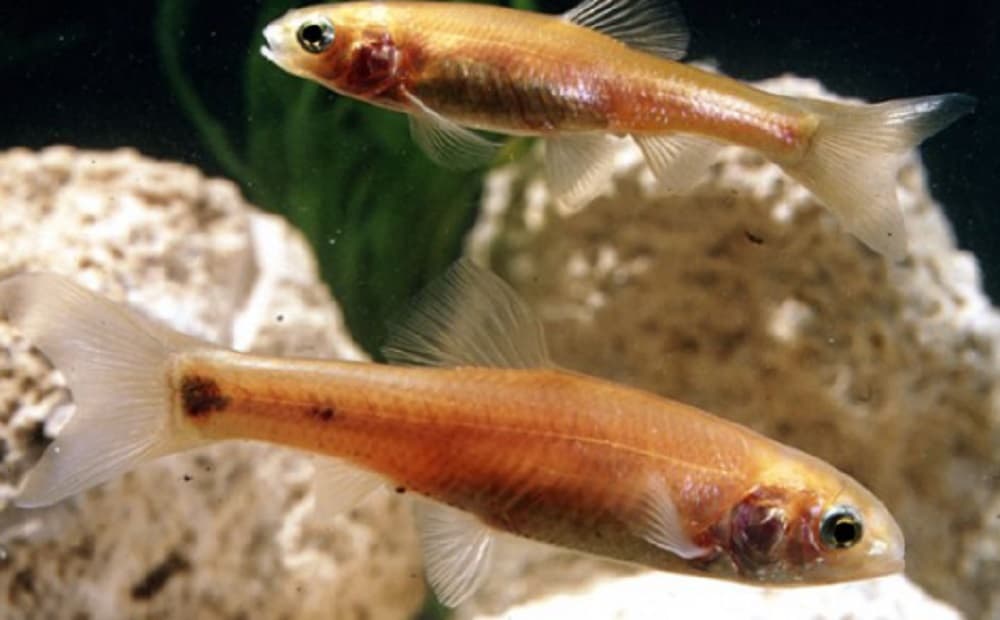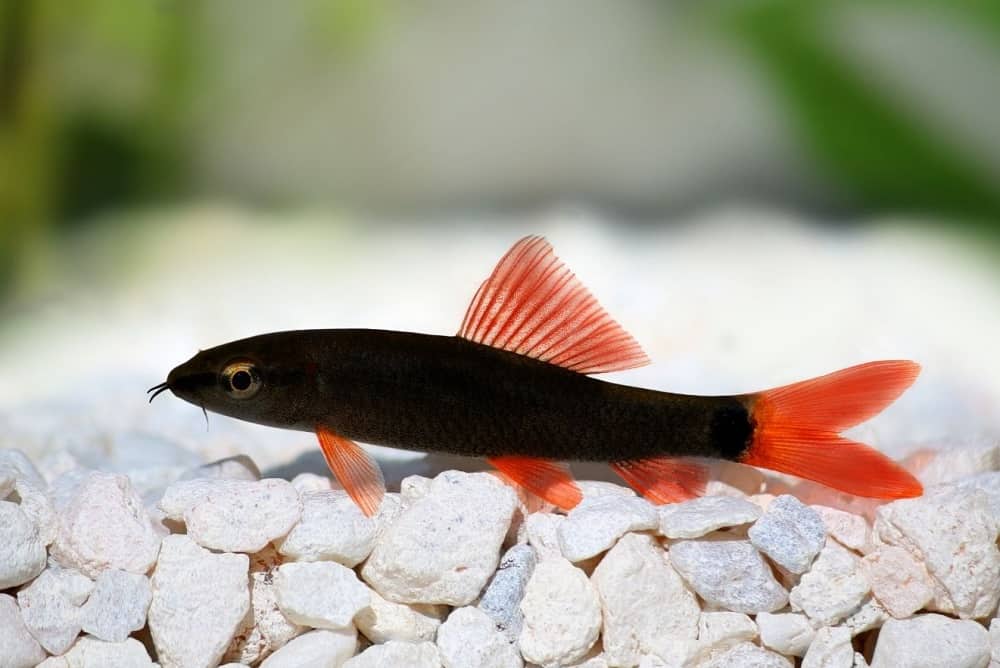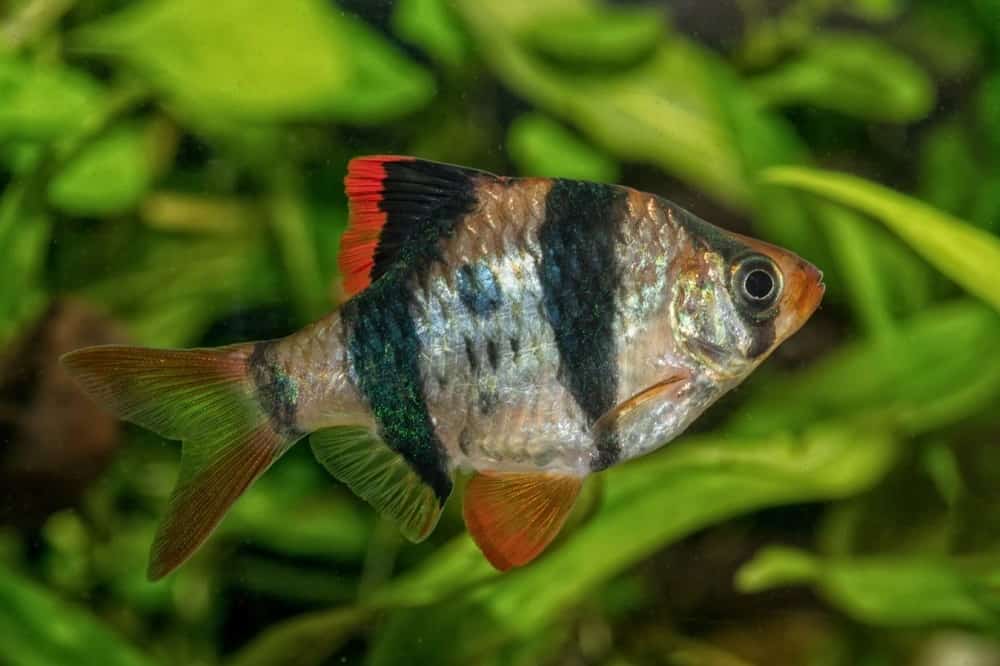The Fathead Minnow, also known by its binomial nomenclature, Pimephales promelas, is native to North America and Canada.
This minnow species is a freshwater fish, and it’s kept both as an aquarium fish and a feeder fish for larger aquarium inhabitants.

Today’s care guide for the Fathead Minnow is geared towards keeping this fish long-term, for those fish keepers who are looking for a small, decorative fish to add to or start off their aquarium.
Keep reading to find out how to set up the perfect tank for a Fathead Minnow, as well as what to feed these fish and how their natural life cycles unfold!
Care Guide
Tank Size
The good thing about keeping Fathead Minnows is the fact that they’re so small, you can keep a pretty sizable group of them in an average-sized aquarium.
However, you should not keep more than 6 Fathead Minnows in a 10-gallon tank. This means that if you want to keep a dozen Fathead Minnows, you should invest in an aquarium with a capacity of at least 20 gallons.
Tank Mates
It’s best to keep Fathead Minnows with other fish of a similar shape, size, and temperament.
For this reason, the simplest solution is to keep Fathead Minnows with other minnow species (or maintain a same species tank: see below).
Danios and Red Shiners are especially good tank mates for the Fathead Minnow. Also, note that the Rosy Red Minnow is not actually a separate species of minnow from the Fathead: it is simply a variant of a different color.
Same Species Tanks
If you choose to keep a same-species tank of Fathead Minnows, you should be aware that these little fish breed very intently and quickly. This can lead to an over-abundance of baby Fathead Minnows, which you may or may not be prepared to house in the long term.
The clear solution to this, if excessive breeding presents a problem for your aquarium arrangement, is to keep a single-sex tank. Luckily, because of certain physical differences between male and female Fathead Minnows (for more, see ‘Gender Differences: Male vs. Female), it’s relatively easy to tell which is which.
You can safely keep an all-male or all-female tank. Although males do exhibit aggressive behavior towards one another by butting heads out of territorial instincts, this doesn’t typically cause injury. Females are able to co-exist peacefully with one another.
Water Parameters
You should aim to keep the temperature of the water in your Fathead Minnow tank between 50 and 70 degrees Fahrenheit. In terms of the pH level, you should monitor this so that it stays between 7 and 7.5.
As you can see from these numbers, the acceptable temperature range for the Fathead Minnow’s living environment is quite broad, but the safe pH range is relatively narrow, so you’ll need to pay close attention to ensure that it stays in this range.
What To Put In Their Tank
If you’re going to be keeping multiple male Fathead Minnows in the same tank, it’s especially important to make sure you have several cave-like structures at the bottom of the aquarium.
The reason for this is that males become territorial when they reach sexual maturity (hence the head-butting we mentioned earlier), and part of this territorial behavior involves finding a cave and guarding it against other male fish.
You can either buy decorative cave structures through online retailers or your local pet store, or you could even use small flower pots (as long as they are unpainted and non-toxic) laid on their sides to replicate this kind of structure.
In your Fathead Minnow’s tank, you should also provide sandy substrate and a basic filtration system to keep the water clean. Otherwise, Fathead Minnows are not a highly demanding species and don’t need much to stay healthy and happy.
Common Diseases
Fathead Minnows, like other minnow species, are quite hardy and resistant to less-than-optimal conditions as well as sickness. Nonetheless, there are some diseases to which the Fathead Minnow is prone.
Bacterial and parasitic infections can affect the Fathead Minnow. Common ailments such as fin rot and infections of skin underneath damaged scales are quite prevalent. Other diseases such as Streptococcus and parasitic worms have been observed regularly in the Fathead Minnow.
Luckily, many of these diseases have relatively simple cures, although problems like infections can quickly become irreversible and fatal if ignored.
Food & Diet
Fathead Minnows (including Rosy Red Minnows) are omnivores, which means that they can feed on other animals as well as vegetation.
It goes without saying that any non-plant-based food you give to your Fathead Minnow will need to be very small, corresponding with the small size of the minnow. Insects and tiny invertebrate animals will satisfy the carnivorous side of your Fathead Minnow’s diet.
With that being said, research has shown that Fathead Minnows actually prefer to eat plant-based foods. Algae and other non-toxic, aquatic plant matter should make up most of the Fathead Minnow’s diet. You can also supplement this with a high-quality fish flake or pellet brand.
Small pieces of brine shrimp or bloodworms that have been frozen are also suitable treats to give your Fathead Minnow on occasion, but make sure not to let these become too frequent.
Lifespan
Fathead Minnows have a very short lifespan of roughly 1 year. In about 20% of cases, Fathead Minnows may live for up to 2 years, and a Fathead Minnow that lives for 3 years may be observed once in a while, but this is very rare.
Appearance
The Fathead Minnow is a very small fish, measuring roughly 3.9 inches in length when fully grown.
Fathead Minnows have relatively stout bodies, with a blunt snout and a short, rounded dorsal fin.
It’s worth noting that the Fathead Minnow can vary quite significantly when it comes to color. Coloring can range from almost entirely black to lighter shades of brown or olive green. Their colors tend to be paler on the underside than on top.
One of the main identifiers, specifically for male Fathead Minnows, is the feature that gives the species its name: a bump of tissue on the head and nape. This feature is present only in males of breeding age, specifically so that they can engage in defensive behaviors such as headbutting.
Size
On average, Fathead Minnows only grow to about 10 centimeters (3.9 inches) long.
Behavior & Temperament
The Fathead Minnow has a peaceful temperament and is not generally aggressive in nature. The primary exception to this, as we mentioned earlier, is the tendency for males to headbutt each other territorially.
Breeding
When it comes to breeding, both the male and female Fathead Minnow take an active role in caring for their offspring.
For the most part, female Fathead Minnows spawn between June and July. The average female can spawn up to 10,600 eggs per year, across as many as 26 spawning events.
Male Fathead Minnows challenge one another for paternity of the eggs, which will have been fertilized by the previous male. Interestingly, a female Fathead Minnow will seek out a male who already has a nest of eggs and will spawn with this male.
As you can imagine, this breeding pattern results in a very high production of offspring in a very short space of time.
Allopaternal care of Fathead Minnow eggs increases egg survival because it’s essentially based on the survival of the fittest. This filters out males who are less capable of taking care of the eggs until they hatch.
Gender Differences: Male vs. Female
The main gender (sex) difference between male and female Fathead Minnows is one that we’ve mentioned in our ‘Appearance’ section (see above). This is the tissue growth that can be found on the heads and napes of male Fathead Minnows for the purpose of combat between breeding males. These are scientifically known as tubercles or epithelial pads.
Another key physical difference between the sexes is the dark band that runs down the side of the male’s body, which is not present in females of the species.
Additionally, females tend to be slightly smaller on average than males in terms of body length, although this is not always a reliable indicator of sex because other factors can have an impact on the size of an adult Fathead Minnow.
Fun Facts
- The Rosy Red Minnow is a differently-colored variation of the Fathead Minnow, which was first bred into existence in Arkansas, in 1985. This type of Fathead Minnow differs from the main variety in terms of color only.
- Female Fathead Minnows can live to over double the average lifespan for this species if they never spawn. Whereas Fathead Minnows who spawn have a lifespan of 1 or perhaps 2 years on average, a female who does not spawn can sometimes live for up to 4 years.








